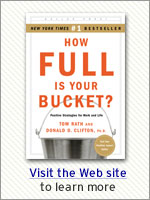As a result of the Positive Psychology movement -- the study of what is right with people -- some of the world's leading academic minds are now devoting their careers to analyzing the effects of positive emotions. At the risk of greatly oversimplifying a decade of in-depth research, many of the world's most noted scientists have put negativity on trial -- and have found it guilty.
 |
These recent studies show that negative emotions can be harmful to your health and might even shorten your life span. We already know that one negative person can ruin an entire workplace, but negative emotions can also destroy relationships, families, and entire careers.
In contrast, recent discoveries suggest that positive emotions are an essential daily requirement for survival. Not only do they improve your physical and mental health, but they can also provide a buffer against depression and illness.
Thousands of moments every day
According to Nobel Prize-winning scientist Daniel Kahneman, we experience approximately 20,000 individual moments in a waking day. Each "moment" lasts a few seconds. If you consider any strong memory -- positive or negative -- you'll notice that the imagery in your mind is actually defined by your recollection of a precise point in time. And rarely does a neutral encounter stay in your mind -- the memorable moments are almost always positive or negative. In some cases, a single encounter can change your life forever. (See "What Were They Thinking?" and "Are You Happy Now?" in See Also.)
In a recent Today segment, Katie Couric interviewed a young man named Brian Bennett who had grown up in a troubled and abusive environment. He had struggled in school and had been picked on regularly at a young age. Now, Brian is a successful and well-adjusted adult. When Couric asked him, "What made the difference?" the young man responded without thinking twice: The defining moment in his life occurred when a grade school teacher simply told him that she cared about him and believed in him. This one small interaction turned Brian Bennett's life around.
In another case, we asked Kristin, a management consultant, "What is the greatest recognition you have ever received?" Her answer: "Three words in an e-mail." We then found out that when Kristin's mother passed away, a mentor at work whom Kristin had admired throughout her career wrote her a special note. Her mentor's e-mail concluded by saying: "Your mother was very proud of you, and so am I." After 25 years with her company, three simple words carried more meaning than any other recognition Kristin had received in her entire life.
The magic ratio
Of course, few moments are this profound, but even less memorable interactions are important. Positive Psychology experts are finding that the frequency of small, positive acts is critical. John Gottman's pioneering research on marriages suggests that there is a "magic ratio" of 5 to 1 -- in terms of our balance of positive to negative interactions. Gottman found that marriages are significantly more likely to succeed when the couple's interactions are near that 5 to 1 ratio of positive to negative. When the ratio approaches 1 to 1, marriages "cascade to divorce."
In a fascinating study, Gottman teamed up with two mathematicians to test this model. Starting in 1992, they recruited 700 couples who had just received their marriage licenses. For each couple, the researchers videotaped a 15-minute conversation between husband and wife and counted the number of positive and negative interactions. Then, based on the 5 to 1 ratio, they predicted whether each couple would stay together or divorce.
Ten years later, Gottman and his colleagues followed up with each couple to determine the accuracy of their original predictions. The results were stunning. They had predicted divorce with 94% accuracy -- based on scoring the couples' interactions for 15 minutes.
This ratio is critical in the workplace as well. A recent study found that workgroups with positive to negative interaction ratios greater than 3 to 1 are significantly more productive than teams that do not reach this ratio. [Barbara] Fredrickson and [Marcial] Losada's mathematical modeling of positive to negative ratios, however, also suggests the existence of an upper limit: Things can worsen if the ratio goes higher than 13 to 1.
So while this book focuses primarily on ways to increase positive emotions, it's important to note that we don't recommend ignoring negativity and weakness; positivity must be grounded in reality. A "Pollyanna" approach, in which the negative is completely ignored, can result in a false optimism that is counterproductive -- and sometimes downright annoying. There are times when it's absolutely necessary to correct our mistakes and figure out how to manage our weaknesses.
But most of us don't have to worry about breaking the upper limit. The positive-to-negative ratios in most organizations are woefully inadequate and leave substantial room for improvement.